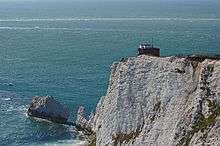The Needles Battery
| The Needles Battery | |
|---|---|
| The Needles, Isle of Wight, England | |
|
The view over the battery | |
 The Needles Battery | |
| Coordinates | 50°39′44″N 1°35′02″W / 50.66213°N 1.58399°W |
| Site information | |
| Owner | National Trust |
| Open to the public | Yes |
| Site history | |
| Built | 1861–63 |
| In use | 1863 onwards |
| Materials | Brick |
The Needles Battery is a military Battery built above the Needles stacks in 1861–63 to guard the West end of the Solent. Its field of fire was from approximately West South West clockwise to Northeast and it was designed to defend against enemy ships.
Old Battery

It was equipped with six 7-inch Armstrong rifled breechloading guns. These were replaced by four 7-inch and two 9-inch rifled muzzle loaders in 1872, and six 9-inch rifled muzzle loaders in 1893. The 9 inch guns took a team of 9 men to load and fire. These guns fired projectiles weighing 256 pounds (116 kg).[1] The 9-inch guns remained in place until 1903 when they were discarded by throwing them over the side of the cliff. These were later recovered and two are on display presently at the Old Battery.[2]
A deep ditch with a retractable bridge was dug into the chalk to protect the facility from ground attack from the island side. In 1885 a tunnel was dug towards the cliff face from the parade grounds. An elevator down to the beach was completed in 1887. Early searchlight experiments were conducted at the site[3] between 1889 and 1892.[2] The present observation post housing a searchlight was built in 1899.[4]
Just to the east of the Old Battery, at Hatherwood Point are the remains of Hatherwood Battery, built to defend the area alongside the Needles Battery.
The Old Battery is a Grade II Listed Building.[5]
The Tunnel
A tunnel leads to a searchlight emplacement with good views towards the Needles lighthouse.
New Battery
Unfortunately, there were subsidence problems and concerns that the concussion from firing the guns was causing the cliffs to crumble. This was solved by building the New Battery higher up the cliff, at a height of 120 metres above sea level. The New Battery was completed in 1895.
Three 9.2-inch Mk IX breech-loading guns were installed at the New Battery : two in 1900 and a third in 1903. A crew of 11 was required to fire one of these guns. Each shell weighed 380 pounds (172 kg).[6] The New Battery guns remained in place until 1954, when they were scrapped.[6]
The Old and New Batteries were manned during the World Wars. German U boats sank two ships off The Needles during World War I.[7] This facility was also the site of early trials of anti-aircraft guns.[2]
In World War II, anti-aircraft guns defended the Isle of Wight against air attacks but repeated German air attacks necessitated improvements in the fortifications at the site. The guns at the Batteries also fired on German torpedo boats attempting night landings. Troops trained for the D-Day landing on the neighbouring cliffs. After the war, the Ministry of Defence deactivated the batteries.[7]
Like the Old Battery, the New Battery has also been listed at Grade II.[8]
National Trust opening
When the site came into the possession of the National Trust, it was decided to restore the Old Battery so that it could be opened to the general public. The National Trust Youth Group comprising local schoolchildren and teachers assisted in getting the site ready for its official opening in 1982.
The site is still managed by the National Trust and is open daily from mid March to the end of October. It gives visitors an insight into how a Victorian battery would work and giving a glimpse into the life of a soldier based at the Battery during the Second World War. Along with a series of exhibition rooms and the tunnel there are a number of visitor facilities including a tearoom.
Gallery
 Gun emplacement at the Old Needles Battery
Gun emplacement at the Old Needles Battery The tunnel, leading to the searchlight.
The tunnel, leading to the searchlight. Searchlight at the end of the "Searchlight Tunnel, Old Needles Battery
Searchlight at the end of the "Searchlight Tunnel, Old Needles Battery
References
- ↑ Source: National Trust plaques on the site
- 1 2 3 History of the Old Battery,The Needles Battery website
- ↑ Location of the searchlight is grid reference SZ295848
- ↑ Needles Old Battery, WightCAM - photographically illustrated walks on the Isle of Wight website
- ↑ Historic England. "Old Needles Battery (1220402)". National Heritage List for England. Retrieved 4 April 2015.
- 1 2 History of the New Battery,The Needles Battery website
- 1 2 The Batteries at war,The Needles Battery website
- ↑ Historic England. "New Needles Battery (1209415)". National Heritage List for England. Retrieved 4 April 2015.
- Anthony Cantwell, "The Needles Battery", Fort, 1985 (Fortress Study Group), (13), pp69–89
External links
![]() Media related to The Needles Battery at Wikimedia Commons
Media related to The Needles Battery at Wikimedia Commons
![]() Media related to Needles New Battery at Wikimedia Commons
Media related to Needles New Battery at Wikimedia Commons
- The Needles Battery - official site
- Victorian Forts data sheet on Old Needles Battery
- Victorian Forts data sheet on New Needles Battery
- Needles Old Battery, WightCAM - photographically illustrated walks on the Isle of Wight website
- Images of the Old Battery